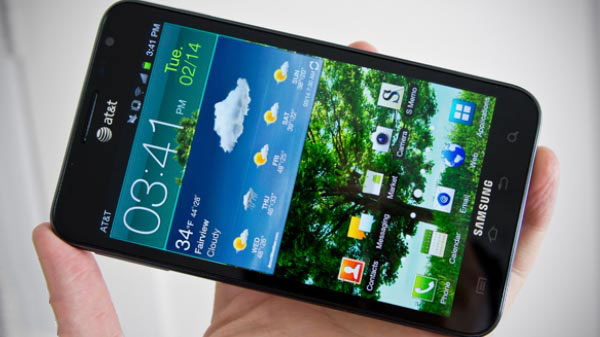Samsung's new Galaxy Note is a unique device in the smartphone market. Straddling the line between a smartphone and a tablet, the Note features a massive 5.3-inch display, which is considerably larger than the screen on any other smartphone available today (just see the image below sitting alongside an iPhone). Because of this, the Note is rather unwieldy in the hand, and nearly impossible to use one handed.
Trying to make the most of the smartphone's larger footprint, Samsung has attempted to add functionality to the Note with its "don't-call-it-a-stylus" S Pen input device. But once again the Note's dominant feature is its 5.3-inch, Super AMOLED display that packs a dense 1280 x 800 pixel resolution. The form factor alone will place many potential buyers at odds, while others might appreciate the hybrid nature of the device. Read on to learn our findings.

The Samsung Galaxy Note borrows heavily from the designs Samsung has used for its Galaxy S II line of smartphones. In fact, one would not be faulted for thinking that the Galaxy Note was just a Galaxy S II on steroids. The big display looks fantastic, with great, punchy colors, tremendous viewing angles, and good outdoor visibility. The pixel layout is the much-derided PenTile format, but since there are so many pixels packed onto the screen, you have to really hunt to see any PenTile patterns in images. It really is a great display.
Because of the massive screen, the Note has equally large dimensions - and therein lie the difficulties I had with using it as a phone. The Note measures 147mm (5.78in) tall and 83mm (3.27in) across, which means that it feels absolutely massive when held in the hand. Even compared to the already large Samsung Galaxy S II Skyrocket with its 4.5-inch display, the Note is a enormous beast (and it makes the 3.5-inch iPhone 4S look positively diminutive). I am unable to reach the corners of the screen with my thumb without having to significantly move the Note around in my hand and stretch to my hand's fullest extent, which gives me concern that the Note will slip out of my hand and fall to the ground.
Thus, using the Galaxy Note is a two-handed affair, and there really isn't a way to get around it – unless you are a pro basketball player, I suppose. However, despite its large dimensions, the Note remains very thin at only 9.7mm (0.38in) thick. As with many thin Samsung smartphones, the thin profile of the Note certainly makes it feel even larger than it actually is.
The rear cover of the Note is made of the familiar, thin plastic material that Samsung has used on many of its prior models, but the Note's back features a classier texture than the others that makes it feel as if it is of higher quality. The textured back helps in handling the device, though I am not sure it will prevent users from eventually dropping it.

Tucked in the lower right corner of the Note's frame is the S Pen input device. The S Pen uses Wacom technology and works with the digitizer in the Note's display to allow users to draw and activate things on the screen with the pen-like tip. The tip has 256 levels of pressure sensitivity, so apps that support the S Pen's capabilities can allow the user to draw thick or thin lines depending on how much pressure they put on the screen.
The S Pen also has a function button on the side of it to perform various tasks like screen capture. Unlike the Scrybe pen for HTC's Flyer tablet, the S Pen does not require a battery. The housing that the S Pen fits into is snug, and the pen won't fall out unintentionally. Still, the S Pen is very thin and small, and many users will likely lose it at some point during their Galaxy Note ownership (AT&T and Samsung are offering replacement S Pens for $29 a pop).

